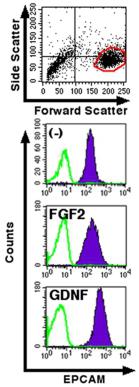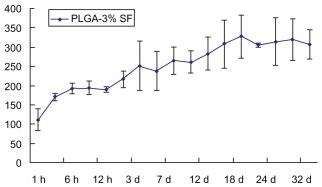Human Glia Maturation Factor beta Recombinant
Category: Neurotrophic factors$70.00 – $4,700.00
Description
Accession
P60983
Source
Optimized DNA sequence encoding Human Glia Maturation Factor beta mature chain was expressed in Escherichia Coli.
Molecular weight
Recombinant Glia Maturation Factor is a monomer protein consisting of 142 amino acid residue subunits,and migrates as an approximately 15 kDa protein under non-reducing and reducing conditions in SDS-PAGE.
Purity
>98%, as determined by SDS-PAGE and HPLC
Biological Activity
ED50 not determined.
Protein Sequence
MSESLVVCDV AEDLVEKLRK FRFRKETNNA AIIMKIDKDK RLVVLDEELE GISPDELKDE LPERQPRFIV YSYKYQHDDG RVSYPLCFIF SSPVGCKPEQ QMMYAGSKNK LVQTAELTKV FEIRNTEDLT EEWLREKLGF FH
Endotoxin
Endotoxin content was assayed using a LAL gel clot method. Endotoxin level was found to be less than 0.1 ng/µg(1EU/µg).
Presentation
Recombinant GMFB was lyophilized from a 0.2 μm filteredmM PB,130mM NaCl solution pH.5.
Reconstitution
A quick spin of the vial followed by reconstitution in distilled water to a concentration not less than 0.1 mg/mL. This solution can then be diluted into other buffers.
Storage
The lyophilized protein is stable for at least years from date of receipt at -20° C. Upon reconstitution, this cytokine can be stored in working aliquots at2° -8° C for one month, or at -20° C for six months, with a carrier protein without detectable loss of activity. Avoid repeated freeze/thaw cycles.
Usage
This cytokine product is for research purposes only.It may not be used for therapeutics or diagnostic purposes.
Molecular function
Methods
Cell preparations
- Peripheral blood mononuclear cells (PBMCs) were isolated and T cell lines were generated as previously described [+ T cells were purified from PBMCs by positive selection coupled to magnetic beads [+ cells in the positively purified population and < 5% in the CD8-depleted population.
- Spontaneous apoptosis of T cells from patients was determined by staining fresh PBMCs with fluorescein isothiocyanate (FITC)-labeled Annexin-V , propidium iodide (PI) and allophycocyanin (APC)-labeled anti-CD3 monoclonal antibody (mAb) .
- Immature (i)DCs were derived from peripheral monocytes and generated as described.
- Monocyte-derived iDCs were purified by positive selection with anti-CD14 mAb coupled to magnetic beads .
- CD14+ cells were incubated for 5 days in Roswell Park Memorial Institute (RPMI) 1640 medium containing 10% FCS, 2 mM glutamine, 1% nonessential amino acids, 1% sodium pyruvate, 50 μg/ml kanamycin , 50 ng/mL recombinant (r)GM-CFS , and 1000 U/mL rIL-4 (generously provided…




